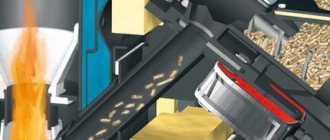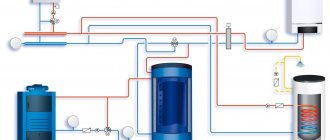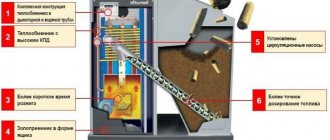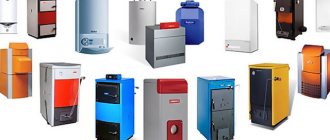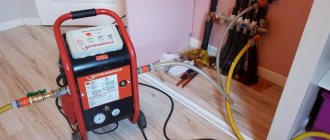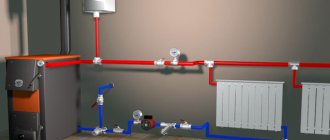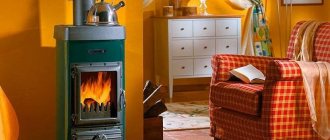Features of combined installations
The main type of fuel is pellets - calibrated granules up to 50 mm in size, made by pressing plant materials. It can be:
- sawdust;
- peat;
- straw;
- sunflower seed husks, waste of corn, other cereal crops, rapeseed.
The small size and dense structure of the pellets allow fuel to be supplied by a screw feeder. This process is easy to automate.
In the production of granules, phenol-formaldehyde resins or other substances harmful to the environment are not used. The binder is lignin, a natural glue released from plant cells under press pressure.
In the absence of pellets and in case of power outages, the combination boiler is heated with the following types of fuel:
- firewood;
- peat;
- briquettes;
- coal.
In the absence of pellets, the boiler can be heated with wood and peat.
The latter variety gives a higher temperature. Therefore, only those boilers for which the manufacturer’s instructions allow the use of this type of fuel can be heated with coal. Otherwise, the device will quickly fail.
Advantages of pellet-wood boilers
The strengths of such heat generators are:
- Autonomy. Unlike a gas device, the device does not depend on external power sources.
- Automatic fuel supply and ignition. If there are pellets, the user approaches the boiler once a week or less, depending on the volume of the bunker.
- Comfort. Unlike diesel fuel, solid fuel does not emit an unpleasant odor when burned.
- On-line power control. To change output, the boiler automatically increases or decreases the pellet feed rate and the volume of forced air.
- Safety. Thanks to zero thermal inertia, energy production stops almost immediately after the feeder stops, which eliminates overheating of the working environment.
- Versatility. Combined models operate on different types of fuel, while a pellet boiler operates only on fuel pellets.
- Fuel availability. Unlike the main gas supply, solid fuel is available in every region.
- When using pellets – high efficiency. It reaches 91-94%, while for purely wood-burning installations it does not exceed 75-82%.
- Low fuel cost. The price of 1 kWh obtained by burning wood is 0.9 rubles, pellets - 1.3, liquefied gas - 2.5, diesel fuel - 2.8, when using electricity - 3.5.
Disadvantages of heating equipment
The negative aspects include:
- Requirement for fuel storage space.
- When using pellets - dependence on electricity supply.
- High cost of equipment.
The high cost of equipment is a disadvantage of pellet-wood boilers.
Making an economical device with your own hands
The pellet boiler has a fairly simple structure, so it is not difficult to assemble it with your own hands. To do this you will need steel pipes or sheets 3-5 millimeters thick, a grinder and a welding machine. If you have never had to deal with welding work before, contact a professional.
The main element of the boiler is the heat exchanger. It is better to make it in a rectangular shape from pipes with a square cross-section. For this:
- Pipes of the same size are taken.
- A round window is made in the vertical rack.
- Holes are cut in the front pipes for drainage (one for cold water, the other for hot water).
- The structural parts are connected using a welding machine.
To ensure even seams, the racks are best placed on a flat surface.
Before carrying out installation work, the device is checked for strength:
- the apparatus is placed vertically;
- close the lower hole;
- pour water into the container.
Attention! The design should not allow liquid to pass through even in small quantities. Otherwise, welding work will need to be done again.
After the boiler has been assembled and checked, installation begins. There are simple rules for installing this device:
The boiler should be installed in a non-residential area, for example, in a basement. It is worth taking care of the floor covering in advance
It is important that the floor is concrete or made of ceramic tiles. The room must be well ventilated
In the room with the boiler, air humidity and temperature are monitored. The boiler room should not be small in size, as it will be inconvenient to carry out maintenance work in it.
The principle of operation of a wood-pellet boiler
The pellets in the burner are ignited automatically using a heating element. Air is pumped into the flame area by a fan. Its quantity and pellet supply speed are adjusted depending on the readings of 2 instruments:
- temperature sensor in the boiler tank;
- a lambda probe that monitors the oxygen concentration in the flue gases.
The principle of operation of the boiler.
When using firewood, the performance of the device is adjusted by an air damper. The flame and hot flue gases heat the heat exchanger and the working medium flowing through it.
Structurally, boilers are divided into single- and double-furnace. Each type has its own characteristics.
Double-furnace
The unit is equipped with 2 cameras. One is used for burning wood, the other has a pellet burner.
This design has significant advantages:
- There is no need to reconfigure the boiler when switching from one type of fuel to another.
- After the wood burns out, the device automatically switches to pellets, which eliminates the need for the user to interrupt sleep and allows him to leave home for a long time.
The disadvantage of this option is its heavy weight. Even with average power it can reach 500 kg. This complicates delivery and installation, and also increases the requirements for the strength of the base.
Single-fuel
Such heat generators are equipped with 1 large chamber with mounts for a pellet burner. They lack the advantages of 2-burner models, but they weigh less and are more compact.
Single-fired boilers are equipped with a large chamber.
Even an experienced user requires at least 15 minutes to install or dismantle a pellet burner.
Classification of combined equipment
There are several types of pellet-wood boilers. They can be classified according to several criteria.
By burner type
There are 3 types of devices for burning pellets:
- flare;
- volumetric;
- fireplace
The former have the following advantages:
- simple design;
- reliability;
- compactness;
- undemanding to fuel quality.
Flaws:
- limited power;
- horizontally directed flame, which causes uneven heating of the boiler.
Pellet-wood boilers differ in the type of burner.
Advantages of a volumetric burner:
- unlimited power;
- higher efficiency than flare.
Flaws:
- complex device;
- big size;
- high requirements for the quality of granules;
- dependence on the angle of inclination (as the amount of slag increases, the amount of slag increases until the feeding mechanism stops);
- long auger (generates wood dust, which negatively affects the operation of the device).
The fireplace burner allows you to admire the flames. It is equipped with a bowl into which pellets are dumped. Air is supplied to the combustion zone from below.
Such models have low efficiency; if there are no special requirements for aesthetics, it is better to choose flare or volumetric.
According to heat exchanger material
Boiler tanks are:
- steel;
- cast iron
Boiler tanks are made of steel.
The advantages of the former include:
- low cost;
- light weight;
- maintainability;
- plastic.
Disadvantages are susceptibility to corrosion and the presence of welded seams in the structure, which limits the service life to 12-14 years.
Cast iron heat exchangers are durable and do not rust, so they work for more than 25 years. But they:
- expensive;
- heavy;
- fragile - when exposed to cold water and impacts, they can crack;
- cannot be restored.
By download method
In different models, the granule feeding speed is adjusted by 2 methods:
- automatically;
- manually.
In most models, the supply of granules is manually adjusted.
The second method is inconvenient, because... the user has to independently monitor the temperature of the coolant.
By number of circuits
A simple boiler is equipped with 1 heat exchanger connected to the heating system. Such units are called 1-circuit.
There are models that additionally perform the function of a water heater. They are called 2-circuit and can be equipped with:
- secondary heat exchanger;
- boiler.
In the first case, flow heating is carried out. When the user opens a hot water tap, the 3-way valve shuts off the heating system and the working fluid begins to circulate through the secondary heat exchanger. With high consumption of hot water, the batteries do not receive enough heat.
A boiler with a boiler is more practical. It has the following advantages:
- heats water only at those moments when the heating circuit does not need heat;
- DHW performance is always high and does not depend on power.
The disadvantages of such installations are their large size and energy losses to maintain the temperature in the storage device.
How to choose a boiler for pellets and wood
First of all, the heater is selected based on power. It should compensate for heat loss during the coldest 5-day period of winter. Their value depends on several factors:
- temperature differences in the house and outside;
- thickness and material of layers of enclosing structures;
- degree of protection from wind;
- glazing area.
A wood-pellet boiler is selected according to power.
A thermal engineering calculation is required, which may seem complicated to a non-specialist.
You can estimate the required performance using a simplified formula:
W=0.1*S, where
W – device power, kW;
S – heated area, sq. m.
This dependence is valid for houses with the following parameters:
- ceiling height 2.5-2.7 m;
- standard sizes of window openings;
- thermal resistance of enclosing structures that meets the requirements of SNiP “Building Climatology” for the given region;
- the presence of double-glazed windows.
In case of abnormal cold weather, it is recommended to add a reserve of 15%-20%. For a 2-circuit boiler, add the same amount so that it is enough to heat the water.
The simplified method gives a large error in both directions; it is recommended not to save money and order a calculation from a heating engineer.
Safety of combi boilers
During operation of the heat generator, the following emergency situations are possible:
- reverse draft with fire escaping into the bunker and igniting the entire supply of fuel pellets;
- when operating on wood, the working medium boils;
- clogging of the chimney and, as a result, the entry of carbon monoxide into the room.
During operation of the boiler, emergency situations are possible.
The following types of fire protection are used:
- A plastic corrugated pipe installed between the auger and the pellet burner. During reverse draft, it melts, as a result of which a gap that is insurmountable for fire is formed between the unit and the bunker.
- 2-screw feeding system. Its design provides for an air gap in the transport channel.
In case the coolant boils near the boiler outlet pipe (no further than 0.5 m), install the so-called. a security group consisting of the following devices:
- air vent;
- safety valve;
- pressure gauge.
It is prohibited to place shut-off valves in the area between the heater and the appliances.
To discharge excess energy, the piping is supplemented with an emergency radiator or heat accumulator. There are models with a cooling coil in the boiler tank connected to the water supply.
The draft in the chimney is controlled using a temperature sensor. If it detects that hot exhaust has stopped flowing into the pipe, the fuel supply is immediately stopped.
Common problems and errors
Low efficiency and frequent breakdowns of heating equipment are a clear sign of mistakes made during its installation.
Mistake #1. Most often, problems arise due to insufficient heating of the coolant. As a result, this leads to the appearance of a large amount of tar or soot.
Mistake #2. Incorrect adjustment or lack of protection against boiling water is one of the most common problems. Because of this, the coolant heats up excessively, which negatively affects heating appliances, pipes and other equipment.
Mistake #3
If the heating system is not highly efficient, then you should pay attention to the quality of the sealing. To do this, you need to check whether the boiler and other structural parts of the system are reliably insulated
Installation of a boiler using pellets and wood
Installation of equipment is carried out taking into account fire safety standards. They are set out in the relevant chapters of SNiP.
Premises requirements
The heater is prohibited from being placed in living rooms.
A wood-pellet boiler requires a special room.
A special room is allocated with the following parameters:
- separate entrance with a width of 0.8 m;
- ceiling height from 2.5 (m);
- volume from 15 cubic meters m + 0.2 for each kW of device power, but not less than 7 (cubic m);
- area from 7 sq. m;
- fire resistance limit of 0.75 hours at walls, partitions and ceilings separating the boiler room from other rooms;
- supply and exhaust ventilation performance corresponding to the power of the heat generator.
The combi boiler must not be installed in the basement.
Boiler room organization
The base for the equipment is selected taking into account its weight (kg):
- up to 200 – cement-sand screed;
- 200-300 – reinforced concrete;
- over 300 – separate foundation.
The distance between the device and the walls is maintained (m):
- from the firebox side – 2;
- on the sides and back - 1.
There must be a distance between the boiler and the wall.
It is allowed to reduce the distance to 0.8 (m) (except for the front part) if the structures are plastered with a fire-resistant compound, for example, vermiculite, 25 mm thick.
The floor within a radius of 1.2 m from the center of the combustion chamber door is protected with a 1.2 mm steel flooring on a thermal insulating substrate made of basalt cardboard.
Fuel storage standards
It is allowed to keep a daily supply of fuel in the boiler room. With an average consumption of pellets and firewood of 2-4 kg/hour, its weight will be 50-100 (kg).
The rest of the fuel is stored in another room at a distance of at least 1 m and no more than 20 (m) from the boiler.
The warehouse must be dry and well ventilated. Flammable materials must not be stored in it or in the furnace room.
Wood dust can explode in high concentrations. To avoid this, take the following measures:
- wipe surfaces regularly, paying special attention to the auger feeder and the area around it;
- ground all non-current-carrying metal parts of the electric drive.
Choosing a smoke removal system
The exhaust pipe must have:
- round or oval cross-section;
- resistance to high temperatures and acids;
- thermal insulation coating;
- vertical arrangement;
- height from 5 m relative to the boiler firebox.
The most popular are prefabricated “sandwich” chimneys made of stainless steel in a shell of mineral wool. The kit includes everything you need: pipes, condensate collectors, grooves, clamps, brackets for mounting to the wall, etc.
The exhaust pipe must be round.
Modern economical boilers produce exhaust with a relatively low temperature - less than +200°C.
As a result, a large amount of acidic condensate forms on the walls of the chimney. If the pipe is made of brick, the liquid saturates it and destroys the masonry in the shortest possible time. To avoid this, such chimneys are lined with stainless steel pipes.
Preparing the premises
When installing a pellet boiler, first of all, you need to properly prepare the room where the heating generator will be located. It is better to use an area remote from housing (basements, outbuildings, garages are good options, sometimes boilers are placed in attics).
If the room with the boiler is located close to the living rooms, then it is better to take care of a tight sealed door and covering the floors and doors with washable materials (wood dust and ash will constantly settle on them). The best option for cladding is standard tiles.
The area of the room for a boiler with a power of 15-18 kW should not be less than 2.5-3 square meters. m., otherwise it violates fire safety rules. The temperature in the room was not below +10 degrees; to achieve this, the walls and ceiling can be insulated with polystyrene foam (a layer of 10 centimeters is enough). There is no need for radiators.
Humidity above 40% is not welcome, as it will reduce the service life of the system - if water gets into the room from the roof or through the walls, you will have to line the perimeter with a waterproofing membrane material.
A few more important conditions when preparing the premises:
- Availability of fresh ventilation. A hole with a diameter of 12-15 centimeters is sufficient. No particularly complex air conditioning systems are required. You can make a hood to make the room comfortable to be in.
- Having access to a chimney or organizing a new one. For pellet boilers, only a sandwich type chimney (with a layer of insulation) is suitable. The height of the pipe must be at least 5 meters. It is recommended to install a condensate collector so that moisture accumulation does not interfere with the operation of the furnace.
- Availability of power supply in the room. Pellet boilers require electricity to automate their operation. It is also recommended to install light into the room, which will greatly facilitate the work on servicing the stove.
General diagram, but read more below
The best models of pellet-wood boilers
Combined heaters are produced by many Russian and foreign companies. A number of models with the best price-quality ratio are especially popular.
Heiztechnik HT Daspell Duo
The Polish unit operates on all types of fuel, incl. on coal. The line includes models with power from 12 to 65 kW.
Description:
- 1 circuit;
- Heiztechnik Pellhard Plus torch burner with self-cleaning and ignition function;
- water-cooled grate;
- electronic weather-compensating automation;
- possibility of installing a display, ash removal system and Internet connection.
Heiztechnik HT Daspell Duo - Polish boiler.
The device is made of steel 5 mm thick.
Zota Pellet 15S
Russian 2-burner unit with a power of 15 kW.
Main characteristics:
- automatic switch to pellets after firewood burns out;
- maximum pressure of the working medium – 3 atm.;
- only forced circulation;
- 2-screw feed (protection against flame penetration into the hopper);
- flow meter – calculates daily and total fuel costs;
- control panel with the ability to connect up to 3 pumps and indicate their priority.
Zota Pellet 15S is a two-furnace unit.
Additionally you can install:
- 12 kW heating elements - turn on automatically if the user forgot to add solid fuel in time;
- GPS module for controlling SMS commands from a smartphone;
- Matrix uninterruptible power supply.
The fire is maintained at the top of the burner, which prevents the auger from burning out.
Automation – weather-sensitive, with programming function.
The device is resistant to high temperatures and voltage surges.
Stropuva Mini S8 P
Lithuanian top combustion boiler with a power of 8 kW. There is no automatic fuel supply. But due to the fact that the load is ignited from above and the air is supplied strictly to the combustion zone, the duration of operation is (in hours):
- wood-burning – 18;
- on briquettes – 30;
- on pellets – 42.
The firebox volume is 163 liters. It holds 106 kg of pellets.
Stropuva Mini S8 P is a top combustion boiler.
The advantage of the heater is energy independence. The coolant temperature and performance are controlled by a bimetallic mechanical sensor connected to the air damper.
Installation efficiency is 85%.
Svetlobor VD 16
Russian equipment with a power of 16 kW. Together with the boiler, a pneumatic fuel supply system from a remote storage facility is offered. It frees the user from even having to load pellets into the hopper. The boiler is approached once a month for maintenance.
Description:
- volumetric type burner;
- automatic cleaning of grates and heat exchanger, removal of ash;
- Efficiency – 94%;
- pellet consumption in nominal performance mode – 3.5 kg/hour;
- weight – 450 kg;
- option – GSM module.
Svetlobor VD 16 – Russian equipment.
The boiler tank is located vertically, which reduces the rate of formation of deposits on its walls.
The entry of flame into the feed auger and hopper is prevented due to the special shape of the burner. It is designed for pellets of any quality.
Metal Fach SD Duo 14
Single-circuit boiler with a capacity of 14 kW, made in Poland. Description:
- water-cooled grate;
- volumetric type burner;
- cast iron screw;
- Efficiency – 90%;
- control – electronic, information is displayed;
- weight – 485 kg;
- ability to connect 4 pumps, weather and room thermostat to the controller.
Metal Fach SD Duo 14 – boiler with a capacity of 14 kW.
The unit operates on all types of fuel, incl. on coal. Fire protection for the feeder must be purchased separately.
Faci Base 15
Italian 1-circuit unit with a power of 15 kW. Equipped with an automatic feeder for the following types of fuel:
- pellet;
- coal up to 15 mm in size.
The volume of the standard bunker (263 l) is enough for 3 days of work.
The device is made of heat-resistant steel and equipped with a volumetric pellet burner.
Fire precautions:
- 2-screw feed;
- screw temperature sensor;
- extinguishing system (emergencyly dumps all ignited pellets into the boiler).
Faci Base 15 is an Italian unit.
Options:
- auto ignition;
- GSM module;
- more spacious bunker.
Efficiency – 92%.
Conversion to gas is possible.
Practical recommendations
Before you start assembling a pellet fireplace stove, you should decide what parts you need to purchase - we are talking about the burner and industrial automation. You should not experiment and assemble the burner yourself. Even if a lot of effort is put into it, its functionality may be very questionable.
It is best to purchase ready-made elements and use them later when assembling a pellet stove. If you make the boiler multifunctional, that is, provide it with a water circuit and the ability to work both on pellets for the fireplace, and on wood and coal, then in the future it can be modernized.
The advantages of a universal boiler will be:
- If there are interruptions in the supply of pellets for the boiler, the boiler can still be used. To do this, remove one burner and put on another to heat the stove with prepared wood and coal.
- Alternatively, you can install a special burner in the boiler for burning natural gas or liquid fuel.
The combustion chamber is usually made of heat-resistant steel 5 mm thick. It is advisable to use ST20 carbon steel for these purposes, but the casing can be made of ST3 sheet steel with a thickness of 3 mm. The fire tubes and chamber doors are made of 6 mm steel, and the grate should be as much as 10 mm thick. In order not to bother with purchasing and assembling parts, sometimes it is much easier to purchase ready-made equipment.
If you make the boiler yourself, you will need a welding machine. The water grate must have very rigid walls. To do this, metal corners or pieces of reinforcement are sometimes welded onto them. At the end of the work, it is necessary to double-check the reliability of all welds. If flaws are found, they must be eliminated.
Reviews for combination boilers
Gennady, 36 years old, Severodvinsk:
“We live in the suburbs, we haven’t installed gas yet. On the advice of a friend, I installed a 2-burner combi boiler. Comfortable. You can burn inexpensive wood, but if you forget to add it, the pellet burner starts.”
Dmitry, 53 years old, Murmansk region:
“I’ve been using a wood-pellet boiler for 2 years now. I took a model with automatic cleaning of the heat exchanger and burner. Removing soot is so-so, you have to do it manually. Otherwise, everything works well, there were no failures during the entire operation.”
Combination boilers combine the advantages of pellet and wood-burning models. Automatic fuel supply is provided, at the same time the user does not depend on the availability of expensive pellets and can switch to cheaper fuel at any time. The boilers are equipped with protection against fire of pellets in the hopper due to reverse draft.
We recommend looking at the rating of pellet boilers.
Comparison table of characteristics
The table of comparative characteristics will help you compare the previously described models and identify the best one based on its parameters through quick selection.
| Model name | Power, W) | Heating area (sq. meters) | Hopper volume (l) | Weight, kg) | Dimensions (mm) | Cost (rubles) |
| KUPPER OK 20 WITH PELLET BURNER | 20 | 200 | 200 | 168 | 740x485x645 | 90 000 – 100 000 |
| Froling P4 Pellet 25 | 25 | 300 | 290 | 435 | 860x770x1280 | 900 000 – 990 000 |
| ZOTA PELLET 25S | 25 | 300 | 332 | 395 | 1660x1140x1100 | 190 000 – 210 000 |
| FACI Base 258 kW | 30 | 290 | 400 | 1500 | 3550x2810x2230 | 700 000 – 800 000 |
| BUDERUS LOGANO S181-25 E | 27 | 216 | 400 | 244 | 1155x1015x1042 | 230 000 – 260 000 |
| STROPUVA S30P | 30 | 240 | 350 | 259 | 1850x680x680 | 90 000 – 100 000 |
| ACV TKAN 1 | 135 | 280 | 240 | 535 | 1420x1170x885 | 250 000 – 300 000 |
